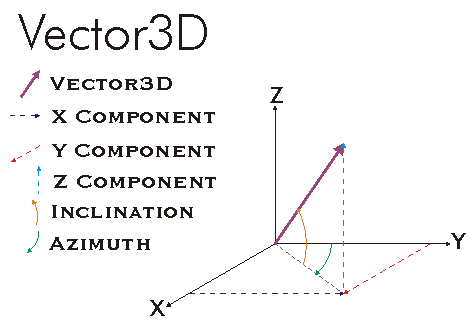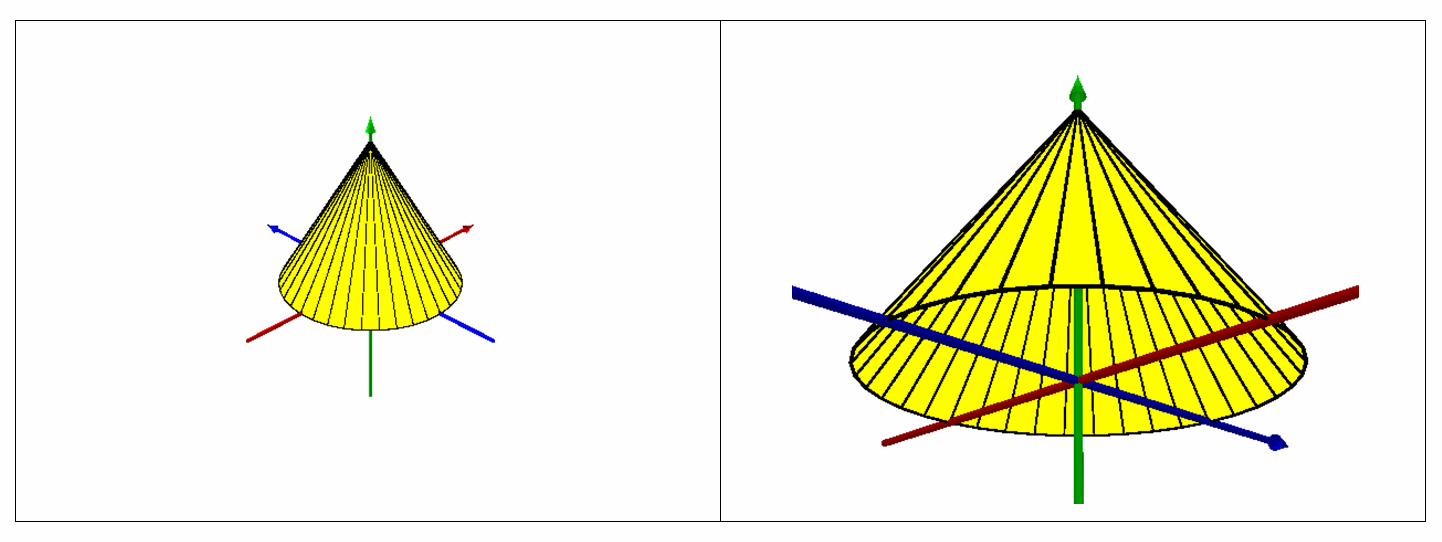 |
This document is archived and information here might be outdated. Recommended version. |
 |
This document is archived and information here might be outdated. Recommended version. |
Provides access to 3D vector properties and operations.
A 3 Dimensional vector with an X Component, Y Component, and Z Component that correspond to the X-Axis, Y-Axis, and Z-Axis respectively. The 3 Dimensional vector can also be defined in terms of spherical coordinates as an angle of rotation (Azimuth) from the YZ-Plane, angle of displacement (Inclination) from the XY-Plane, and a length (Magnitude). This vector can be manipulated by any of the general Vector operations as well as operations specific to the third dimension.
| Name | Description | |
|---|---|---|
 |
AddVector | Construct a new vector by adding a different vector to this vector. |
 |
Azimuth | The vector's azimuth angle in radians. |
 |
ComponentByIndex | The component corresponding to a given index. |
 |
ConstructAddVector | Set this vector by adding two input vectors. |
 |
ConstructCrossProduct | Set this vector equal to the cross product of the two input vectors. |
 |
ConstructDifference | Set the vector by taking the difference of point1 and point2 (so the vector would go from point2 to point1). |
 |
ConstructSubtractVector | Set this vector by subtracting the second input vector from the first one. |
 |
CrossProduct | Returns the cross product of this vector and another vector. |
 |
Dimension | The dimension of this vector. |
 |
DotProduct | Returns the dot product of this vector and another vector. |
 |
Inclination | The vector's inclination in radians. |
 |
IsEmpty | Indicates if the vector is empty (unset). |
 |
Magnitude | The length of the vector. |
 |
Move | Move the vector by adding a shift value to each component. |
 |
Normalize | Normalize the vector (scale it to magnitude=1). |
 |
PolarMove | Modify the vector by adding to its polar components. Angles are in radians. |
 |
PolarQuery | Get the vector's polar components. Angles are in radians. |
 |
PolarSet | Set the vector using polar components. Angles are in radians. |
 |
QueryComponents | Get the values of the vector's components. |
 |
Rotate | Rotate the vector around an axis defined by another vector. The angle is in radians. |
 |
Scale | Scale the vector by the given factor. |
 |
SetComponents | Set the values of the vector's components. |
 |
SetEmpty | Makes the vector empty (unset). |
 |
SubtractVector | Construct a new vector by subtracting a different vector from this vector. |
 |
XComponent | The vector's X component. |
 |
YComponent | The vector's Y component. |
 |
ZComponent | The vector's Z component. |
| Interfaces | Description |
|---|---|
| IVector | Provides access to vector properties and operations. |
| CoClasses and Classes | Description |
|---|---|
| Vector3D | A 3D vector containing dx, dy, and dz components. |


private static object _missing=Type.Missing;
public static IGeometry GetMultiPatchGeometry()
{
const double ConeBaseDegrees=360.0;
const int ConeBaseDivisions=36;
const double VectorComponentOffset=0.0000001;
const double ConeBaseRadius=6;
const double ConeBaseZ=0.0;
const double ConeApexZ=9.5;
//Vector3D: Cone, TriangleFan With 36 Vertices
IGeometryCollection multiPatchGeometryCollection=new MultiPatchClass();
IPointCollection triangleFanPointCollection=new TriangleFanClass();
//Set Cone Apex To (0, 0, ConeApexZ)
IPoint coneApexPoint=ConstructPoint3D(0, 0, ConeApexZ);
//Add Cone Apex To Triangle Fan
triangleFanPointCollection.AddPoint(coneApexPoint, ref _missing, ref _missing);
//Define Upper Portion Of Axis Around Which Vector Should Be Rotated To Generate Cone Base Vertices
IVector3D upperAxisVector3D=ConstructVector3D(0, 0, 10);
//Define Lower Portion of Axis Around Which Vector Should Be Rotated To Generate Cone Base Vertices
IVector3D lowerAxisVector3D=ConstructVector3D(0, 0, -10);
//Add A Slight Offset To X or Y Component Of One Of Axis Vectors So Cross Product Does Not Return A Zero-Length Vector
lowerAxisVector3D.XComponent += VectorComponentOffset;
//Obtain Cross Product Of Upper And Lower Axis Vectors To Obtain Normal Vector To Axis Of Rotation To Generate Cone Base Vertices
IVector3D normalVector3D=upperAxisVector3D.CrossProduct(lowerAxisVector3D) as IVector3D;
//Set Normal Vector Magnitude Equal To Radius Of Cone Base
normalVector3D.Magnitude=ConeBaseRadius;
//Obtain Angle Of Rotation In Radians As Function Of Number Of Divisions Within 360 Degree Sweep Of Cone Base
double rotationAngleInRadians=GetRadians(ConeBaseDegrees / ConeBaseDivisions);
for (int i=0; i < ConeBaseDivisions; i++)
{
//Rotate Normal Vector Specified Rotation Angle In Radians Around Either Upper Or Lower Axis
normalVector3D.Rotate(-1 * rotationAngleInRadians, upperAxisVector3D);
//Construct Cone Base Vertex Whose XY Coordinates Are The Sum Of Apex XY Coordinates And Normal Vector XY Components
IPoint vertexPoint=ConstructPoint3D(coneApexPoint.X + normalVector3D.XComponent,
coneApexPoint.Y + normalVector3D.YComponent,
ConeBaseZ);
//Add Vertex To TriangleFan
triangleFanPointCollection.AddPoint(vertexPoint, ref _missing, ref _missing);
}
//Re-Add The Second Point Of The Triangle Fan (First Vertex Added) To Close The Fan
triangleFanPointCollection.AddPoint(triangleFanPointCollection.get_Point(1), ref _missing, ref _missing);
//Add TriangleFan To MultiPatch
multiPatchGeometryCollection.AddGeometry(triangleFanPointCollection as IGeometry, ref _missing, ref _missing);
return multiPatchGeometryCollection as IGeometry;
}
private static IPoint ConstructPoint3D(double x, double y, double z)
{
IPoint point=ConstructPoint2D(x, y);
point.Z=z;
return point;
}
private static IPoint ConstructPoint2D(double x, double y)
{
IPoint point = new PointClass();
point.PutCoords(x, y);
return point;
}
private static double GetRadians(double decimalDegrees)
{
return decimalDegrees * (Math.PI / 180);
}